 Facebook
Facebook
 X
X
 Instagram
Instagram
 TikTok
TikTok
 Youtube
Youtube
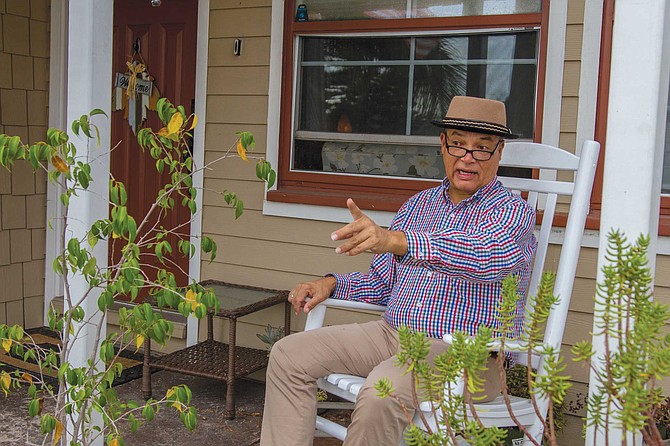
“I hear them screeching”
Frank Arredondo has seen them, romping down his La Mesa street as if they owned it: coyotes. “I sit out on the front porch, and I smoke and drink coffee. Usually it’s early, before sunup.” Arredondo, my next-door neighbor, wears reading glasses perched out near the tip of his nose. He has dark, trimmed hair and olive-ish skin. We sit out in the evening chill in wood chairs on my front porch.
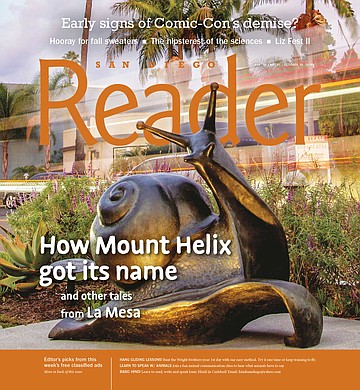
“In May,” he thinks is when he saw the most of them, sniffing around just outside his grapevine-covered yard fence. “And in June. And I’ve seen them since. My brother has, too. In the morning, and in the daytime. You can tell that they’re definitely wild animals.”
Others of our neighbors haven’t seen them, but they have experienced the consequences of living with stealthy, free-range predators. “Coyote Area!!” warns a small hand-lettered sign posted within walking distance of Arredondo’s front porch. “Keep small dogs close at all times day or night,” reads the sign. His own dogs are small, well under nine pounds apiece. He worries about them, his dogs, and he keeps them indoors most all of the time. He knows of neighborhood cats that have gone missing.
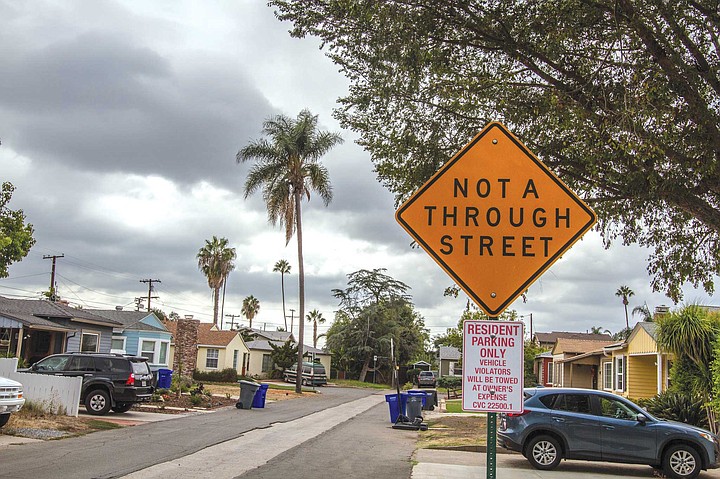
“Coyotes,” he says. “I hear them screeching at night.” Who in La Mesa does not? It is a troublesome sound, both familiar yet primal, nothing at all like what you hear in a cowboy movie, and out of step with the usual nocturnal sounds of a bedroom community: televisions, random traffic, dogs barking at the breeze.
“See those trees up there?” Arredondo, 53, nods upward toward a grove of eucalyptus trees maybe three blocks to the southwest of us, tall, crooked, and spindly-white. “There’s open space behind there. That’s where I think the coyotes den up. The name of our neighborhood?” he says, peering outward into the dusk. “University Park.”
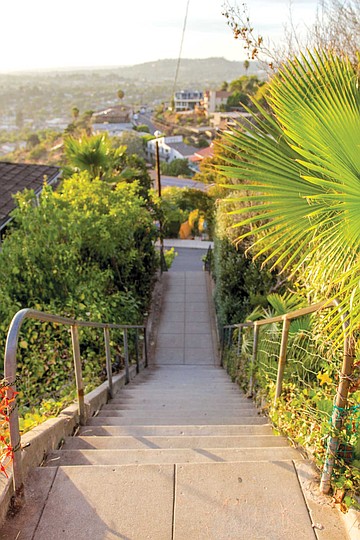
This, he says, explains why the streets around us are named after fancy college campuses and military academies: Harvard, Stanford, Annapolis, Berkeley, Purdue, West Point, Pomona, Vassar, Cornell, and Yale. No sidewalks here, nor lights. But the streets are paved, and nearly everyone has a little square of yard. By day, the silence is interrupted by the oily rattle of lawn mowers, cawing crows, and the echoes of porch flags snapping like rifle shots in the afternoon breeze. American flags. Not so blue here, University Park is red territory.
“Not University Heights — University Park,” Arredondo says. He says he grew up five miles from here, in Spring Valley. “Olive groves,” he says, “were all around us. You know they discovered a snail species? Helix aspersa? It’s a Latin name. So, there is a Helix Street in Spring Valley, and that’s how Helix Charter High School got its name. After the snail. I read that in the Spring Valley Historical Society.”
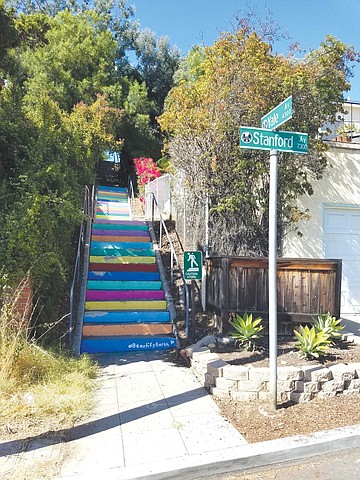
I am not able to verify the actual origins of the name of Helix High School (now Helix Charter High School) but Mount Helix, the uppermost landmark inside of La Mesa city limits — its peak at roughly 1300 feet above sea level — was indeed named after helix aspersa. This happened, after a Swiss naturalist named Louis Agassiz reportedly found what is now known as the common garden snail — a native of the Mediterranean region — on a hike there one morning.
Agassiz did not name Mount Helix, but Rufus King Porter did. Porter owned the hill at the time of the naturalist’s discovery in 1872. A large bronze garden snail named Felix the Helix commemorates the occasion from inside of the kiosk at the turnaround on 4th, Allison, and La Mesa Boulevard in the Village. Add helix aspersa to the list of wildlife that inhabits the urban jungle of La Mesa.
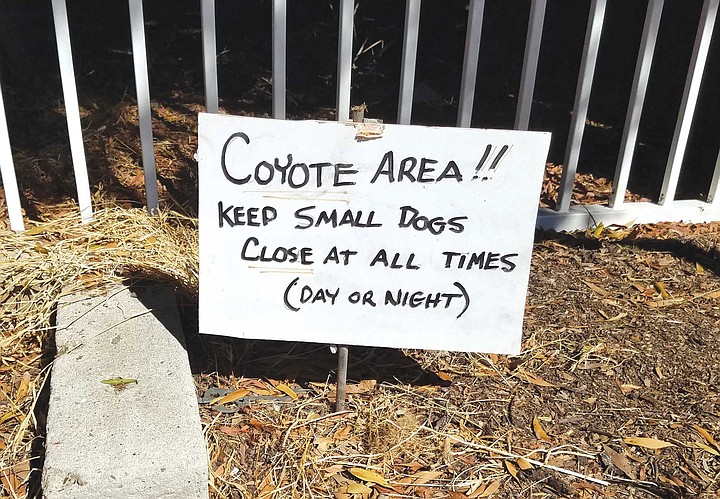
“Rats, mice, raccoons, possums, and skunks,” Arredondo says. “I haven’t actually seen the skunks, but I smell ‘em, especially after my dogs got zapped by one. It was late at night. They got skunked when I put them out to pee. They came back in and oh no. It was terrible. They say tomato juice neutralizes the stink,” he says. “I used up all the Bloody Mary mix I had.”
Railways and stairways
La Mesa is a dot on the map of Southern California that took shape and gained momentum in the late 1800s with the completion of a wooden flume that carried water aboveground from Cuyamaca Lake. The town boasted a stop on the San Diego and Cuyamaca Railways. But whatever urban growth city fathers may have intended then was stunted by drought, and later by the end of railway passenger service in 1928. In the mid-1950s, the Lakeside Chamber of Commerce bought the La Mesa Depot ticket office for one dollar. The building was re-purposed over the years as a worm farm and a chicken coop. In 1974, the Pacific Southwest Railway Museum Association bought the remains of the structure back for one dollar, restored it, and returned it to the original 1915 location in the La Mesa Village, where it stands to this day next to the trolley tracks.
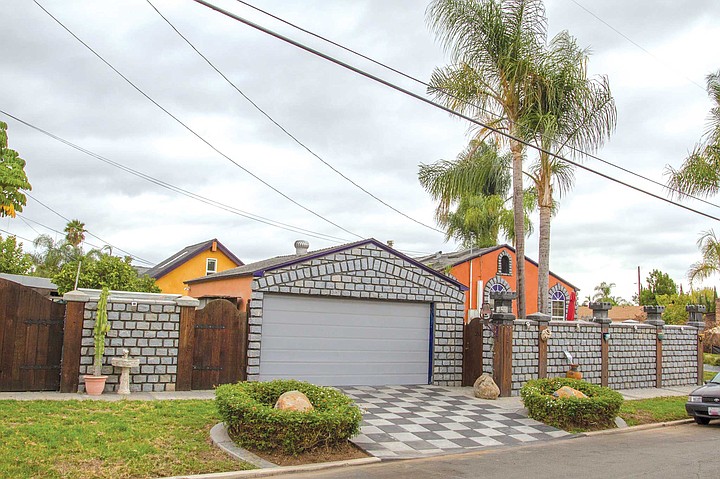
“La Mesa” is Spanish for “the tableland,” or plateau. Official city signs declare it to be “The Jewel of the Hills.” It is a nine-square mile city unto itself (it was incorporated in 1912), with a downtown village verging on the small-town throwback architecturally. La Mesa may be known to outsiders for two main features: Oktoberfest, an annual three-nighter that draws 200,000 visitors, and great cardio. La Mesa is one of the few neighborhoods inside of San Diego that is connected by an infrastructure of concrete stairs. One set of rainbow-hued steps connects Stanford to West Point in University Park, but the mother of all stairs is up on Mount Nebo. From the city of La Mesa’s own website:
“From the intersection of Windsor Drive and Canterbury Drive, you climb a total of 245 steps, interrupted by two cross streets, to reach the top of Summit Drive. On reaching the 245th step, at Summit Drive, you’re on one of La Mesa’s highest knolls, elevation 830 feet. Continue by following Summit Drive about 100 yards to a second stairway descending east. Follow its 184 steps to Beverly Drive. A third, shorter stairway can be found on Fairview Avenue near Alta Lane. Ascend 44 steps, cross Pasadena Avenue, and continue via the remaining 16 steps and a paved pathway to Vista Drive.”
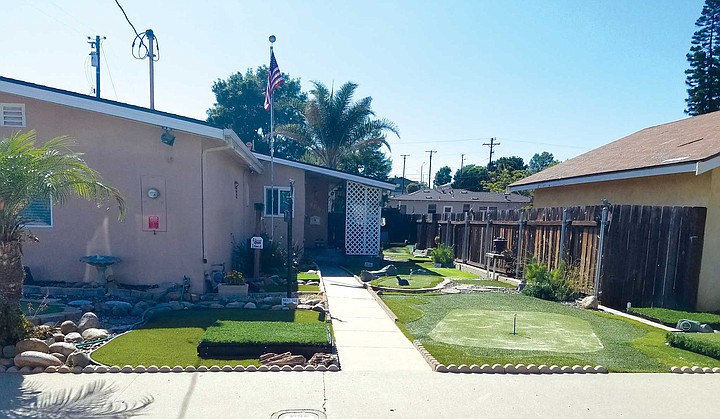
“So many different La Mesas”
There is clearly no kind of HOA in control of my University Park neighborhood. Over on Harvard Avenue, for example, one homeowner looks to have attempted to transform his or her home into a small-scale medieval castle. Another favors the log cabin look, while another still has turned his entire front yard into a miniature golf course. Bougainvillea is the official flower of La Mesa. Neighborhoodscout.com claims that your chances of being a victim of a violent crime in La Mesa are 1 in 371, well below the California average of 1 in 223. Not much tagging, nor gangs, and there are few street people here, although many intersections support panhandlers.
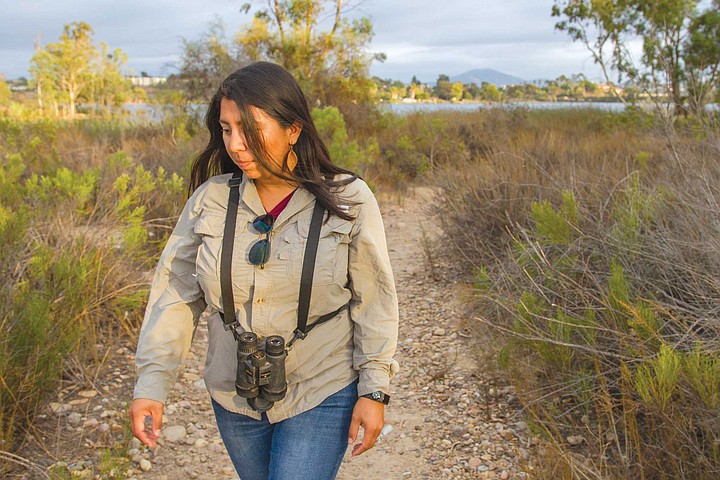
The biggest drama so far this year in University Park happened in March. A tree trimmer’s three-ton truck slipped its wheel blocks, rolled down West Point (a very steep hill), shot across busy Harbinson Avenue, and planted itself deep into the Sunday school building of the San Diego Taiwanese Presbyterian Church. A miracle, perhaps, that no one was injured.
I ask Frank Arredondo for his overall take on what, exactly, La Mesa is. “Call it the La Mesas,” he says, as in La Mesa plural. “So many different La Mesas,” he says. “Oh absolutely.”

“Am I aware of the coyotes?” Janel Ortiz says. “Definitely. They surround us because of the canyons that surround us. They’re opportunists. They’ll utilize dog food, cat food. Rodents are their natural diet, but in neighborhoods, they find tastier alternatives.”
Ortiz is a University of San Diego biology instructor. When we talk, she is in west Texas doing field research. By “tastier alternatives,” does she mean pets? Yes. She warns that coyotes can hop six-foot fences. She says that your basic coyote doesn’t need much in the way of living accommodations.
“They’ve been documented to live under freeway overpasses, in backyards, any places where they can find a nook or cranny. Sometimes, people don’t even know they’re living in their back yards.” For more La Mesa sightings, she suggests I scan a web site called iNaturalist.

A joint initiative of the California Academy of Sciences and the National Geographic Society, iNaturalist is an online place to record encounters with living things. In the search bar, I punch in “coyote” and “La Mesa.” The latest sighting at the time of writing is dated June 14, 2019. The coyote stood still for its portrait. The thing was seen at 5777 Lake Murray Boulevard, just outside a chain-link fence that separates a small church from a thicket of wild scrub.
“The city has evolved in blocks and chunks.” This is assistant city manager Gregory Humora’s answer to my question about the wide range of building styles and design parameters that overlap within the nine square miles of La Mesa. “When we do have subdivisions — and it’s rare — you’ll see design similarities.” Otherwise, he admits, not so much.
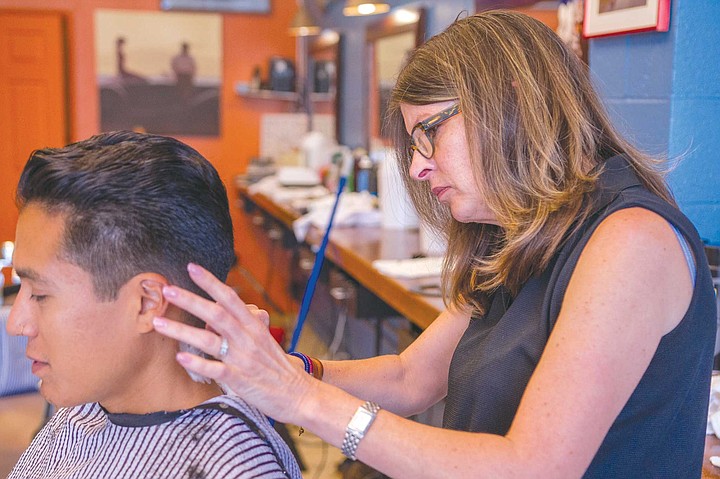
“But we’re one big neighborhood. It’s the ideal size for a city,” says Humora. “60,000 people. You can get from one side of town to the other easily.”
I ask if there is likewise one master plan that would unify all of La Mesa into one cohesive community with amenities such as sidewalks and street lights. Humora refers to what he calls city planning documents.
“They take a long time to put together. And there’s no timeline, specifically, which makes it challenging for me to answer neighborhood questions like, ‘When are we getting sidewalks?’ ‘When will our utilities be undergrounded?’” He refers me to the city website.
“We’ve also identified neighborhoods that prefer the rural feel, neighborhoods that don’t want sidewalks.” I check the list on the City of La Mesa web site. It is long. Vassar, my street, is not on it. By the looks of the city planning map, University Park is destined for sidewalks — someday.
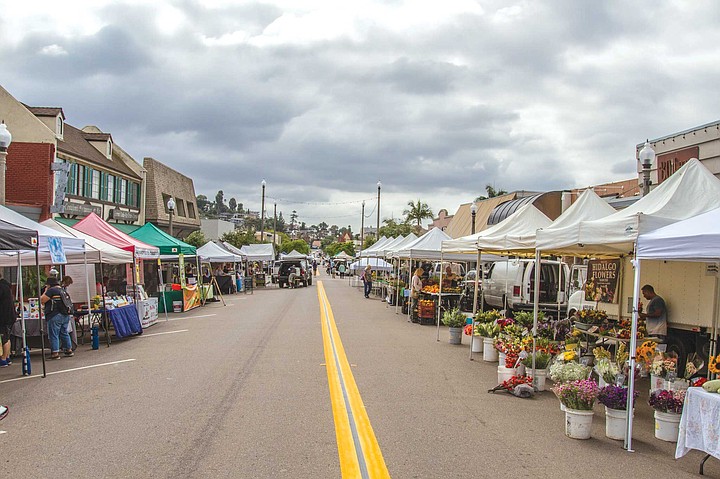
Sharp Grossmont Hospital, he explains, is La Mesa’s biggest employer. The business of water looms large as well, but Humora says that Helix Water itself is a special district. “They serve 200,000 customers in outlying areas like Spring Valley and Lemon Grove, but they are headquartered in La Mesa.”
Arredondo was spot-on. La Mesa is indeed many La Mesas. Only two college-named streets escape University Park: Stanford and Yale Avenues. But Stanford terminates westbound at 70th Street and points toward the east San Diego neighborhood of Rolando. Yale, on the other hand, crosses University Avenue, wanders the west perimeter of Helix’s campus, then courses steadily uphill into neighborhoods with sidewalks, streetlights, underground power lines, and mid-sized 1970s-era tract homes that are modern in that post-Kennedy sort of way. In the opposite direction, towards Cowles Mountain, some tracts of La Mesa homes offer views of Lake Murray. Now owned by San Diego, it was called the La Mesa Reservoir in the late 1800s, and nearby Cowles Mountain in San Carlos.
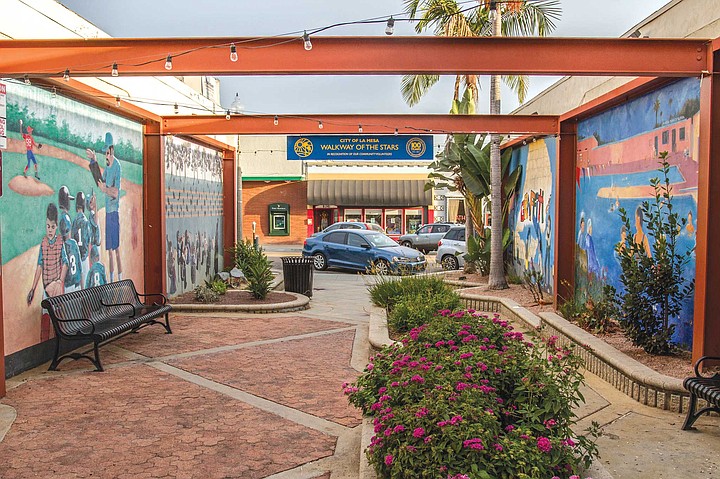
Overlooking the La Mesa Village itself is Mount Nebo, a wide range of SoCal architectural styles clinging to a sort of little brother to Mount Helix, two miles east. Like its big brother, Mount Nebo is home to narrow streets, designer homes, and history. Howard Brubeck, jazz pianist Dave Brubeck’s older brother, was possibly Mount Nebo’s most illustrious resident.
“Did you know he had a studio in there?” Jack Pinney says one morning as we walk past the impressive home Brubeck once lived in. “I’ll bet Joe Morello visited.”
Pinney, a drummer who was a founding member of one of the early versions of the Iron Butterfly band (“Way before they recorded that hit song,” he likes to point out) would wonder such a thing. Joe Morello was Dave Brubeck’s drummer.
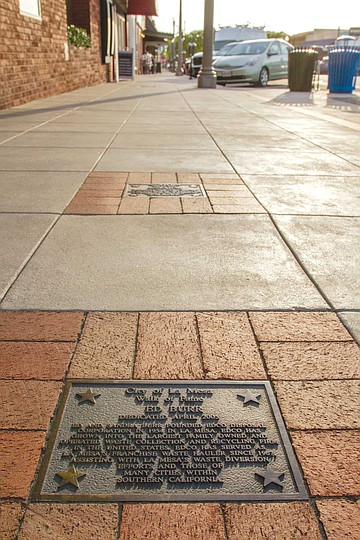
“That hillside up behind where A-1 Rentals used to be, down on University Avenue?” Early on a Thursday morning, a woman who identifies herself only as Newmark returns my call. “There’s enough greenbelt for coyotes to live up there.” Newmark works for La Mesa Animal Control. She says it is department policy not to give out first names. “And Harry Griffen Park,” she says. “There’s always a few coyotes in there.” Newmark says that she does indeed get random phone complaints about coyotes, but that La Mesa Animal Control only deals with domestics. “They are not our jurisdiction.” She says this year she’s seen a lower coyote volume than in years past, judging by the phone calls. “Remember back when it rained hard for all that time? The result was that there were a lot of things to eat, because rodent and rabbit populations escalated.”
How many coyotes are there in La Mesa, and is the population growing? Newmark does not know. She suggests I call Fish and Game for answers to those questions.
I do. They don’t know, either.
“Coyotes? Yeah. My wife saw one in our back yard with a cat in its mouth. It vaulted a five-foot fence with no trouble. I found parts of the cat later.” No, it was not his cat. James Newland is an author and historian. We meet in the small back-building on the lot of the Victorian era residence that is now the La Mesa Historical Society on Pine Street.
“We live in Boulder Heights. It overlooks the Village.”
Dressed like a college professor in a greenish long-sleeve T-shirt and jeans, Newland’s got close-cropped dark brown hair. “Can I teach? Yes. Do I teach? Sometimes,” he says, putting emphasis on the word ‘“sometimes.” He is a wealth of information, which flows in a steady, quick stream without a hint of hesitation. More important, he knows how the streets of my neighborhood got their curious names.
“In 1926 or 1927,” Newland says, “John Snyder developed University Park. The streets were named after colleges because San Diego State College (now University) was looking for land to build on. Snyder reasoned that his land would be worth more money if the campus settled near his land.” University Park, then, was essentially bait. Directly across University Avenue was a huge tract of land called Murray Acres, after the land owner James A. Murray, the same Murray for whom Ed Fletcher would eventually name the lake. “Rolando, Pacific Beach, and Mission Palisades all put in bids for San Diego State College. Ed Fletcher pitched the site in Murray Acres, which is now where Helix High School sits.”
A later development, Academy Heights, surrounds University Park, but in spite of the name, it has no streets named for colleges.
“La Mesa has always been considered a bedroom community,” Newland says. “By 1940, our population was 4000, and 50,000 by 1980. It’s only grown to about 60,000 now.” He describes La Mesa as mostly post-war tract. “People stay in the area. The Village is updating. You see new businesses.” He feigns amazement. “Are those 25-year-olds in the Coin Haus? Where did they come from?” He laughs.
“When my wife and I lived in Rolando 25 years ago, we had the baby stroller. Now, we’re seeing more families with baby strollers. The mythology is that La Mesa never changes. There’s always been change here. Along our corridors, we could pull in some density in ways that are good for everybody. El Cajon Boulevard,” he says, “has always been zoned for four stories. And Grossmont Center,” he opines, “is due for a major re-do.”
“By the way,” he says, “La Mesa never was that big into lemons. We didn’t have enough water. Drought eventually killed the flume,” he says, “and with it any chance at farming. Poultry,” he explains, “was the solution. Poultry was the big business on La Mesa farms.”
High times
For a time during 2017, medical marijuana also looked to be La Mesa’s big business. It all started when voters approved Title 24.23, also known as Measure U, in November 2016. Following the people’s thumbs-up, dispensaries suddenly opened all over town, next to schools, churches, even a senior day center. None at that time were legal.
“It’s a little bit like whack-a-mole,” a former city official named Carol Dick told me back then. She was the community development director for the city of La Mesa at the time. “As soon as you close one down, another one opens up.”
The plan was for the city of La Mesa to begin accepting applications consistent with the published appointment schedule for Conditional Use Permits to authorize facilities outlined in Measure U. But that didn’t happen. Dick said that City Hall wasn’t ready. Instead, opportunists rented any and every retail space they could find, blacked out the windows, and hung the green cross.
At one time I counted 16 pot shops – nearly two per square mile within La Mesa’s city limits. Consider that the city had already closed down an additional 16 dispensaries. Dick said at that time that there were 29 such applications on file. Only a few of them were green-lighted. Today, according to weedmaps.com, there are three such dispensaries operating legally inside of La Mesa.
Can the intellectual temperature of University Park be gauged by the books it (presumably) reads and then discards? There are at least a half-dozen of those little volunteer book-lending kiosks planted in suburban lawns around my neighborhood. They hold mostly pulps and cookbooks and diet plans and such, but every now and then, a gem: a Garrison Keillor or a John Updike or a Barbara Kingsolver will pop up.
The three in U-Park are jammed with Dean Koontz and Robert Ludlum thrillers. Up on Pomona, John Grisham and Edith Wharton and Wendell Berry are on the small shelves. On Harvard, a chair has been converted to book storage; Langston Hughes, and the Book of Mormon in Spanish are standouts. Over on Allison behind the Village, the little box offers up Nora Roberts and Lee Child, Pierce Brown and Brad Meltzer.
“I left a bunch of prayer guides in that book thing,” an old neighbor who has since moved from University Park to Santee once complained. “And a Bible, and some books about what a rat bastard that (expletive deleted) Hillary Clinton is. And they just sit there, them books. I check, every day.”
Indeed; I actually observed her in the act one morning while on a walk.
“What the hell kinda neighborhood is this?” she asked me, smoke curling from a cigarette pasted to her bottom lip. Good question. For the answer to that, I needed the help of a pro, someone who spends a lot of time with a random cross section of La Mesans.
“Six years ago, in November” is how Kristy Allenson answers my question about how long she’s had her barber shop in the Village. She is slender, affable, and her expression lies somewhere between calm and exhausted. She tells me she works six days a week here, 10 hours a day. She had to put me on the schedule a week ahead before she had an open time slot. Does she likewise live in La Mesa?
“I do.” Allenson and her husband, she says, live on Mt. Helix. Does she know about how a snail was responsible for the naming of her ‘hood?
“Yeah. But not until they put that snail sculpture in the kiosk up the street.”
Coyotes?
Yes. “We had seven in our backyard at one time I’ll play you a recording I made not too long ago.” She produces a smart phone. She plays back a recording of what sounds like a hundred coyotes howling.
“This is every day at 5:30 in the morning.” She looks tired. “Every day.”
Has she ever seen a coyote saunter up the main street?
No.
“Do you want to sit outside? There are chairs.” We park in front of her store. There is something small-town and time-honored in this act. If this was Arkansas, for instance, we’d be sitting on a covered porch next to older men in faded coveralls.
“The people that live here seem to be passionate about living here,” she says. “I think that’s why they fought so hard for the farmer’s market.” On Friday afternoons, a block-long stretch of La Mesa Blvd. in the Village is given over to a small farmer’s market. “The city council voted to take it away from the La Mesa Business Association. So we no longer have the revenue. I don’t know why. Oktoberfest is still put on by the LMBA, but we don’t have much funding for that either.”
I ask her to tell me what, in a word, La Mesa is.
“Friendly.”
She says that people wave to each other here. She tells me about a man who brings her a flower each day. “He sticks it in a hole in the door. He says the flower is not for me, it’s for my dog Cody.” Right then, Cody, Allenson’s yellow Lab, limps out to join us on the sidewalk in front of the store.
“No, Cody,” she says. “Not in the sun. Over here.” Allenson tugs the big, gentle dog onto a patch of shaded sidewalk. She breaks open a sack of some kind of jerky. For her, not the dog.
“The man’s dog, his dog is named Ryder. He says his Ryder has a strong connection, because Ryder knows Cody isn’t feeling well.”
I ask Allenson to characterize the type of person who lives in La Mesa. “A lot of young families are moving here.” As if on cue, a youngish mother leads three school-age children into Boulevard Barber and Shave. Allenson rises slowly, then turns to follow them inside.
“I have to go cut hair,” she says, standing in the doorway of her shop. “The future of La Mesa? I don’t know. I’m here 10 hours a day six days a week. I don’t have time to go to Business Association meetings.”
“There are almost no feral cat problems in California anymore.” Peter Tira, the public information officer for the California Department of Fish and Wildlife, is not making a joke. He is serious. Since the urban bloom in coyote populations, his agency is seeing fewer feral cats, and there is a dent in the rat/mouse populations as well. He checks in by phone and tells me there is no coyote abatement program in place in La Mesa, or anywhere else in California. He suggests sounding an air horn, or throwing rocks. He calls it hazing. “Anything to make coyotes less comfortable with their surroundings tends to make them move on.”
“Nobody wants change”
“When I was mayor,” Art Madrid recalls, “people would call in and complain. ‘There are coyotes in the streets,’ they’d say. ‘This is a residential community. We want you to come out here and shoot them.’” Madrid and I meet at one of his favorite haunts, the Chili’s on Fletcher Parkway. He orders a lunch that consists of iced tea and a hamburger patty with tomato slices. He carefully salts his tomatoes, then looks up from his plate.
“It’s illegal to shoot coyotes,” he says. “And if I recall correctly, at that time, there were only two game wardens in the entire state licensed to shoot anything.” Did Madrid ever have to call in the big guns? No.
“My take on it? Those coyotes were here first” Madrid, it turns out, was a live-and-let-live mayor. “We moved into their territory.”
Madrid is 85. Long retired from public service (La Mesa Council member for 10 years, mayor for 24 years, and a member at times in his career of better than 140 boards). He looks fit and rested in a yellow pullover and shorts. He says he still golfs.
“Every day is Saturday. And Costco opens at 10 am.” He grins.
I remind him that a few years ago, when he and I were chatting at a Scripps Grossmont Hospital fundraiser, Madrid laid out his plan for a three-story parking structure in the Village. I almost laughed. Back then, the Village all but closed up at 8:30 pm. But now, in the weeks and months following a complete street-and-sidewalk renovation and the opening of a bevy of new restaurants, one is hard pressed to find a parking spot.
Although Madrid was not mayor during the construction (he lost a bid for what would have been his seventh term to a councilmember named Mark Arapostathis,) “It was priority from day one as mayor,” he says of the Village sidewalk re-construction, a major project that lasted years and saw both sides of the street and sidewalks demolished then replaced with wider sidewalks, a leveled street, drains, new irrigation, trees, benches, and lighting.
He produces a color photo taken in the Village back in the early 2000s. The sidewalk trees look withered. One of them appears to be dead. “That tree was 25 years old. It hadn’t been watered since 1990.” Madrid’s creative blueprint for downtown La Mesa was borrowed from Little Italy, and from villages in Napa, CA, and Coeur d’Alene, Idaho.
“You gotta travel. You gotta learn from others. What can we use? What can we implement?” So how many such ideas was Madrid able to launch on his home turf? With thumb and index finger he makes the symbol for zero.
“All these pushbacks. Nobody wants change.”
But Madrid says he was responsible for implementing the La Mesa Walk of Fame, among other things, along with an innovative public awareness program designed to push prostitutes out of the area by publishing the pictures of Johns. “That got us in Time magazine.” He grins. The Walk consists of small bronze plaques embedded in Village sidewalks. Names include auto dealer Elmer Drew, EDCO founder Ed Burr, and shuttle astronaut Ellen Ochoa.
“She took a La Mesa flag to space and back,” Madrid explains. “We rolled it tight and stuck it into a length of one-inch PVC tubing. Absent on the Walk of Fame are the arts. No present-day hometown La Mesa musicians such as Slightly Stoopid’s Andy Geib or national touring jazz pianist Danny Green, or even former La Mesa heavy-hitters such as Megadeth founder Dave Mustaine or Pearl Jam’s Eddie Vedder, or Howard Brubeck, or Dennis Hopper, the famous actor and Helix High School graduate.
“By the way, do you know why all those antique stores were in the Village?” asks Madrid. He says that at one time there were 19 of them, and that before antiques, La Mesa was the massage parlor capitol of East County.
I guess correctly: cheap rent.
“That’s right,” he says. “After the new sidewalks went in, property owners started raising the rents, and they all moved on.”
My first coyote
Finally, I saw one in the flesh. My first bona fide coyote. It was early on a weekday morning. The lone animal was trotting uphill on Pomona Avenue, which is the eastern boundary of University Park. It was larger than I expected, and neat, as if it had just come from the groomer. The coyote’s overall demeanor appeared calm but alert. It never once looked in my direction. Passing cars did not deter the beast the slightest bit. I couldn’t have been 25 yards away from it, which was kind of thrilling.
Then the coyote stopped, turned, and pointed its nose up a yellow dirt driveway. It finally sauntered up the drive, past the unkempt house, and melted into a mess of pepper trees at the back of the lot. I stared after it. A woman came into my peripheral vision. Tallish, with a thick nest of dark hair, she was walking the opposite direction down Pomona.
“Did you see that?” I practically shouted at her. “That coyote?”
The sighting brought out my inner 10-year-old.
“No.” Her expression was suspicious.
“Did you hear them howling last night?”
“No.” Same suspicious expression. The woman never broke stride.


“I hear them screeching”
Frank Arredondo has seen them, romping down his La Mesa street as if they owned it: coyotes. “I sit out on the front porch, and I smoke and drink coffee. Usually it’s early, before sunup.” Arredondo, my next-door neighbor, wears reading glasses perched out near the tip of his nose. He has dark, trimmed hair and olive-ish skin. We sit out in the evening chill in wood chairs on my front porch.

“In May,” he thinks is when he saw the most of them, sniffing around just outside his grapevine-covered yard fence. “And in June. And I’ve seen them since. My brother has, too. In the morning, and in the daytime. You can tell that they’re definitely wild animals.”
Others of our neighbors haven’t seen them, but they have experienced the consequences of living with stealthy, free-range predators. “Coyote Area!!” warns a small hand-lettered sign posted within walking distance of Arredondo’s front porch. “Keep small dogs close at all times day or night,” reads the sign. His own dogs are small, well under nine pounds apiece. He worries about them, his dogs, and he keeps them indoors most all of the time. He knows of neighborhood cats that have gone missing.

“Coyotes,” he says. “I hear them screeching at night.” Who in La Mesa does not? It is a troublesome sound, both familiar yet primal, nothing at all like what you hear in a cowboy movie, and out of step with the usual nocturnal sounds of a bedroom community: televisions, random traffic, dogs barking at the breeze.
“See those trees up there?” Arredondo, 53, nods upward toward a grove of eucalyptus trees maybe three blocks to the southwest of us, tall, crooked, and spindly-white. “There’s open space behind there. That’s where I think the coyotes den up. The name of our neighborhood?” he says, peering outward into the dusk. “University Park.”

This, he says, explains why the streets around us are named after fancy college campuses and military academies: Harvard, Stanford, Annapolis, Berkeley, Purdue, West Point, Pomona, Vassar, Cornell, and Yale. No sidewalks here, nor lights. But the streets are paved, and nearly everyone has a little square of yard. By day, the silence is interrupted by the oily rattle of lawn mowers, cawing crows, and the echoes of porch flags snapping like rifle shots in the afternoon breeze. American flags. Not so blue here, University Park is red territory.
“Not University Heights — University Park,” Arredondo says. He says he grew up five miles from here, in Spring Valley. “Olive groves,” he says, “were all around us. You know they discovered a snail species? Helix aspersa? It’s a Latin name. So, there is a Helix Street in Spring Valley, and that’s how Helix Charter High School got its name. After the snail. I read that in the Spring Valley Historical Society.”

I am not able to verify the actual origins of the name of Helix High School (now Helix Charter High School) but Mount Helix, the uppermost landmark inside of La Mesa city limits — its peak at roughly 1300 feet above sea level — was indeed named after helix aspersa. This happened, after a Swiss naturalist named Louis Agassiz reportedly found what is now known as the common garden snail — a native of the Mediterranean region — on a hike there one morning.
Agassiz did not name Mount Helix, but Rufus King Porter did. Porter owned the hill at the time of the naturalist’s discovery in 1872. A large bronze garden snail named Felix the Helix commemorates the occasion from inside of the kiosk at the turnaround on 4th, Allison, and La Mesa Boulevard in the Village. Add helix aspersa to the list of wildlife that inhabits the urban jungle of La Mesa.

“Rats, mice, raccoons, possums, and skunks,” Arredondo says. “I haven’t actually seen the skunks, but I smell ‘em, especially after my dogs got zapped by one. It was late at night. They got skunked when I put them out to pee. They came back in and oh no. It was terrible. They say tomato juice neutralizes the stink,” he says. “I used up all the Bloody Mary mix I had.”
Railways and stairways
La Mesa is a dot on the map of Southern California that took shape and gained momentum in the late 1800s with the completion of a wooden flume that carried water aboveground from Cuyamaca Lake. The town boasted a stop on the San Diego and Cuyamaca Railways. But whatever urban growth city fathers may have intended then was stunted by drought, and later by the end of railway passenger service in 1928. In the mid-1950s, the Lakeside Chamber of Commerce bought the La Mesa Depot ticket office for one dollar. The building was re-purposed over the years as a worm farm and a chicken coop. In 1974, the Pacific Southwest Railway Museum Association bought the remains of the structure back for one dollar, restored it, and returned it to the original 1915 location in the La Mesa Village, where it stands to this day next to the trolley tracks.

“La Mesa” is Spanish for “the tableland,” or plateau. Official city signs declare it to be “The Jewel of the Hills.” It is a nine-square mile city unto itself (it was incorporated in 1912), with a downtown village verging on the small-town throwback architecturally. La Mesa may be known to outsiders for two main features: Oktoberfest, an annual three-nighter that draws 200,000 visitors, and great cardio. La Mesa is one of the few neighborhoods inside of San Diego that is connected by an infrastructure of concrete stairs. One set of rainbow-hued steps connects Stanford to West Point in University Park, but the mother of all stairs is up on Mount Nebo. From the city of La Mesa’s own website:
“From the intersection of Windsor Drive and Canterbury Drive, you climb a total of 245 steps, interrupted by two cross streets, to reach the top of Summit Drive. On reaching the 245th step, at Summit Drive, you’re on one of La Mesa’s highest knolls, elevation 830 feet. Continue by following Summit Drive about 100 yards to a second stairway descending east. Follow its 184 steps to Beverly Drive. A third, shorter stairway can be found on Fairview Avenue near Alta Lane. Ascend 44 steps, cross Pasadena Avenue, and continue via the remaining 16 steps and a paved pathway to Vista Drive.”

“So many different La Mesas”
There is clearly no kind of HOA in control of my University Park neighborhood. Over on Harvard Avenue, for example, one homeowner looks to have attempted to transform his or her home into a small-scale medieval castle. Another favors the log cabin look, while another still has turned his entire front yard into a miniature golf course. Bougainvillea is the official flower of La Mesa. Neighborhoodscout.com claims that your chances of being a victim of a violent crime in La Mesa are 1 in 371, well below the California average of 1 in 223. Not much tagging, nor gangs, and there are few street people here, although many intersections support panhandlers.

The biggest drama so far this year in University Park happened in March. A tree trimmer’s three-ton truck slipped its wheel blocks, rolled down West Point (a very steep hill), shot across busy Harbinson Avenue, and planted itself deep into the Sunday school building of the San Diego Taiwanese Presbyterian Church. A miracle, perhaps, that no one was injured.
I ask Frank Arredondo for his overall take on what, exactly, La Mesa is. “Call it the La Mesas,” he says, as in La Mesa plural. “So many different La Mesas,” he says. “Oh absolutely.”

“Am I aware of the coyotes?” Janel Ortiz says. “Definitely. They surround us because of the canyons that surround us. They’re opportunists. They’ll utilize dog food, cat food. Rodents are their natural diet, but in neighborhoods, they find tastier alternatives.”
Ortiz is a University of San Diego biology instructor. When we talk, she is in west Texas doing field research. By “tastier alternatives,” does she mean pets? Yes. She warns that coyotes can hop six-foot fences. She says that your basic coyote doesn’t need much in the way of living accommodations.
“They’ve been documented to live under freeway overpasses, in backyards, any places where they can find a nook or cranny. Sometimes, people don’t even know they’re living in their back yards.” For more La Mesa sightings, she suggests I scan a web site called iNaturalist.

A joint initiative of the California Academy of Sciences and the National Geographic Society, iNaturalist is an online place to record encounters with living things. In the search bar, I punch in “coyote” and “La Mesa.” The latest sighting at the time of writing is dated June 14, 2019. The coyote stood still for its portrait. The thing was seen at 5777 Lake Murray Boulevard, just outside a chain-link fence that separates a small church from a thicket of wild scrub.
“The city has evolved in blocks and chunks.” This is assistant city manager Gregory Humora’s answer to my question about the wide range of building styles and design parameters that overlap within the nine square miles of La Mesa. “When we do have subdivisions — and it’s rare — you’ll see design similarities.” Otherwise, he admits, not so much.

“But we’re one big neighborhood. It’s the ideal size for a city,” says Humora. “60,000 people. You can get from one side of town to the other easily.”
I ask if there is likewise one master plan that would unify all of La Mesa into one cohesive community with amenities such as sidewalks and street lights. Humora refers to what he calls city planning documents.
“They take a long time to put together. And there’s no timeline, specifically, which makes it challenging for me to answer neighborhood questions like, ‘When are we getting sidewalks?’ ‘When will our utilities be undergrounded?’” He refers me to the city website.
“We’ve also identified neighborhoods that prefer the rural feel, neighborhoods that don’t want sidewalks.” I check the list on the City of La Mesa web site. It is long. Vassar, my street, is not on it. By the looks of the city planning map, University Park is destined for sidewalks — someday.

Sharp Grossmont Hospital, he explains, is La Mesa’s biggest employer. The business of water looms large as well, but Humora says that Helix Water itself is a special district. “They serve 200,000 customers in outlying areas like Spring Valley and Lemon Grove, but they are headquartered in La Mesa.”
Arredondo was spot-on. La Mesa is indeed many La Mesas. Only two college-named streets escape University Park: Stanford and Yale Avenues. But Stanford terminates westbound at 70th Street and points toward the east San Diego neighborhood of Rolando. Yale, on the other hand, crosses University Avenue, wanders the west perimeter of Helix’s campus, then courses steadily uphill into neighborhoods with sidewalks, streetlights, underground power lines, and mid-sized 1970s-era tract homes that are modern in that post-Kennedy sort of way. In the opposite direction, towards Cowles Mountain, some tracts of La Mesa homes offer views of Lake Murray. Now owned by San Diego, it was called the La Mesa Reservoir in the late 1800s, and nearby Cowles Mountain in San Carlos.

Overlooking the La Mesa Village itself is Mount Nebo, a wide range of SoCal architectural styles clinging to a sort of little brother to Mount Helix, two miles east. Like its big brother, Mount Nebo is home to narrow streets, designer homes, and history. Howard Brubeck, jazz pianist Dave Brubeck’s older brother, was possibly Mount Nebo’s most illustrious resident.
“Did you know he had a studio in there?” Jack Pinney says one morning as we walk past the impressive home Brubeck once lived in. “I’ll bet Joe Morello visited.”
Pinney, a drummer who was a founding member of one of the early versions of the Iron Butterfly band (“Way before they recorded that hit song,” he likes to point out) would wonder such a thing. Joe Morello was Dave Brubeck’s drummer.

“That hillside up behind where A-1 Rentals used to be, down on University Avenue?” Early on a Thursday morning, a woman who identifies herself only as Newmark returns my call. “There’s enough greenbelt for coyotes to live up there.” Newmark works for La Mesa Animal Control. She says it is department policy not to give out first names. “And Harry Griffen Park,” she says. “There’s always a few coyotes in there.” Newmark says that she does indeed get random phone complaints about coyotes, but that La Mesa Animal Control only deals with domestics. “They are not our jurisdiction.” She says this year she’s seen a lower coyote volume than in years past, judging by the phone calls. “Remember back when it rained hard for all that time? The result was that there were a lot of things to eat, because rodent and rabbit populations escalated.”
How many coyotes are there in La Mesa, and is the population growing? Newmark does not know. She suggests I call Fish and Game for answers to those questions.
I do. They don’t know, either.
“Coyotes? Yeah. My wife saw one in our back yard with a cat in its mouth. It vaulted a five-foot fence with no trouble. I found parts of the cat later.” No, it was not his cat. James Newland is an author and historian. We meet in the small back-building on the lot of the Victorian era residence that is now the La Mesa Historical Society on Pine Street.
“We live in Boulder Heights. It overlooks the Village.”
Dressed like a college professor in a greenish long-sleeve T-shirt and jeans, Newland’s got close-cropped dark brown hair. “Can I teach? Yes. Do I teach? Sometimes,” he says, putting emphasis on the word ‘“sometimes.” He is a wealth of information, which flows in a steady, quick stream without a hint of hesitation. More important, he knows how the streets of my neighborhood got their curious names.
“In 1926 or 1927,” Newland says, “John Snyder developed University Park. The streets were named after colleges because San Diego State College (now University) was looking for land to build on. Snyder reasoned that his land would be worth more money if the campus settled near his land.” University Park, then, was essentially bait. Directly across University Avenue was a huge tract of land called Murray Acres, after the land owner James A. Murray, the same Murray for whom Ed Fletcher would eventually name the lake. “Rolando, Pacific Beach, and Mission Palisades all put in bids for San Diego State College. Ed Fletcher pitched the site in Murray Acres, which is now where Helix High School sits.”
A later development, Academy Heights, surrounds University Park, but in spite of the name, it has no streets named for colleges.
“La Mesa has always been considered a bedroom community,” Newland says. “By 1940, our population was 4000, and 50,000 by 1980. It’s only grown to about 60,000 now.” He describes La Mesa as mostly post-war tract. “People stay in the area. The Village is updating. You see new businesses.” He feigns amazement. “Are those 25-year-olds in the Coin Haus? Where did they come from?” He laughs.
“When my wife and I lived in Rolando 25 years ago, we had the baby stroller. Now, we’re seeing more families with baby strollers. The mythology is that La Mesa never changes. There’s always been change here. Along our corridors, we could pull in some density in ways that are good for everybody. El Cajon Boulevard,” he says, “has always been zoned for four stories. And Grossmont Center,” he opines, “is due for a major re-do.”
“By the way,” he says, “La Mesa never was that big into lemons. We didn’t have enough water. Drought eventually killed the flume,” he says, “and with it any chance at farming. Poultry,” he explains, “was the solution. Poultry was the big business on La Mesa farms.”
High times
For a time during 2017, medical marijuana also looked to be La Mesa’s big business. It all started when voters approved Title 24.23, also known as Measure U, in November 2016. Following the people’s thumbs-up, dispensaries suddenly opened all over town, next to schools, churches, even a senior day center. None at that time were legal.
“It’s a little bit like whack-a-mole,” a former city official named Carol Dick told me back then. She was the community development director for the city of La Mesa at the time. “As soon as you close one down, another one opens up.”
The plan was for the city of La Mesa to begin accepting applications consistent with the published appointment schedule for Conditional Use Permits to authorize facilities outlined in Measure U. But that didn’t happen. Dick said that City Hall wasn’t ready. Instead, opportunists rented any and every retail space they could find, blacked out the windows, and hung the green cross.
At one time I counted 16 pot shops – nearly two per square mile within La Mesa’s city limits. Consider that the city had already closed down an additional 16 dispensaries. Dick said at that time that there were 29 such applications on file. Only a few of them were green-lighted. Today, according to weedmaps.com, there are three such dispensaries operating legally inside of La Mesa.
Can the intellectual temperature of University Park be gauged by the books it (presumably) reads and then discards? There are at least a half-dozen of those little volunteer book-lending kiosks planted in suburban lawns around my neighborhood. They hold mostly pulps and cookbooks and diet plans and such, but every now and then, a gem: a Garrison Keillor or a John Updike or a Barbara Kingsolver will pop up.
The three in U-Park are jammed with Dean Koontz and Robert Ludlum thrillers. Up on Pomona, John Grisham and Edith Wharton and Wendell Berry are on the small shelves. On Harvard, a chair has been converted to book storage; Langston Hughes, and the Book of Mormon in Spanish are standouts. Over on Allison behind the Village, the little box offers up Nora Roberts and Lee Child, Pierce Brown and Brad Meltzer.
“I left a bunch of prayer guides in that book thing,” an old neighbor who has since moved from University Park to Santee once complained. “And a Bible, and some books about what a rat bastard that (expletive deleted) Hillary Clinton is. And they just sit there, them books. I check, every day.”
Indeed; I actually observed her in the act one morning while on a walk.
“What the hell kinda neighborhood is this?” she asked me, smoke curling from a cigarette pasted to her bottom lip. Good question. For the answer to that, I needed the help of a pro, someone who spends a lot of time with a random cross section of La Mesans.
“Six years ago, in November” is how Kristy Allenson answers my question about how long she’s had her barber shop in the Village. She is slender, affable, and her expression lies somewhere between calm and exhausted. She tells me she works six days a week here, 10 hours a day. She had to put me on the schedule a week ahead before she had an open time slot. Does she likewise live in La Mesa?
“I do.” Allenson and her husband, she says, live on Mt. Helix. Does she know about how a snail was responsible for the naming of her ‘hood?
“Yeah. But not until they put that snail sculpture in the kiosk up the street.”
Coyotes?
Yes. “We had seven in our backyard at one time I’ll play you a recording I made not too long ago.” She produces a smart phone. She plays back a recording of what sounds like a hundred coyotes howling.
“This is every day at 5:30 in the morning.” She looks tired. “Every day.”
Has she ever seen a coyote saunter up the main street?
No.
“Do you want to sit outside? There are chairs.” We park in front of her store. There is something small-town and time-honored in this act. If this was Arkansas, for instance, we’d be sitting on a covered porch next to older men in faded coveralls.
“The people that live here seem to be passionate about living here,” she says. “I think that’s why they fought so hard for the farmer’s market.” On Friday afternoons, a block-long stretch of La Mesa Blvd. in the Village is given over to a small farmer’s market. “The city council voted to take it away from the La Mesa Business Association. So we no longer have the revenue. I don’t know why. Oktoberfest is still put on by the LMBA, but we don’t have much funding for that either.”
I ask her to tell me what, in a word, La Mesa is.
“Friendly.”
She says that people wave to each other here. She tells me about a man who brings her a flower each day. “He sticks it in a hole in the door. He says the flower is not for me, it’s for my dog Cody.” Right then, Cody, Allenson’s yellow Lab, limps out to join us on the sidewalk in front of the store.
“No, Cody,” she says. “Not in the sun. Over here.” Allenson tugs the big, gentle dog onto a patch of shaded sidewalk. She breaks open a sack of some kind of jerky. For her, not the dog.
“The man’s dog, his dog is named Ryder. He says his Ryder has a strong connection, because Ryder knows Cody isn’t feeling well.”
I ask Allenson to characterize the type of person who lives in La Mesa. “A lot of young families are moving here.” As if on cue, a youngish mother leads three school-age children into Boulevard Barber and Shave. Allenson rises slowly, then turns to follow them inside.
“I have to go cut hair,” she says, standing in the doorway of her shop. “The future of La Mesa? I don’t know. I’m here 10 hours a day six days a week. I don’t have time to go to Business Association meetings.”
“There are almost no feral cat problems in California anymore.” Peter Tira, the public information officer for the California Department of Fish and Wildlife, is not making a joke. He is serious. Since the urban bloom in coyote populations, his agency is seeing fewer feral cats, and there is a dent in the rat/mouse populations as well. He checks in by phone and tells me there is no coyote abatement program in place in La Mesa, or anywhere else in California. He suggests sounding an air horn, or throwing rocks. He calls it hazing. “Anything to make coyotes less comfortable with their surroundings tends to make them move on.”
“Nobody wants change”
“When I was mayor,” Art Madrid recalls, “people would call in and complain. ‘There are coyotes in the streets,’ they’d say. ‘This is a residential community. We want you to come out here and shoot them.’” Madrid and I meet at one of his favorite haunts, the Chili’s on Fletcher Parkway. He orders a lunch that consists of iced tea and a hamburger patty with tomato slices. He carefully salts his tomatoes, then looks up from his plate.
“It’s illegal to shoot coyotes,” he says. “And if I recall correctly, at that time, there were only two game wardens in the entire state licensed to shoot anything.” Did Madrid ever have to call in the big guns? No.
“My take on it? Those coyotes were here first” Madrid, it turns out, was a live-and-let-live mayor. “We moved into their territory.”
Madrid is 85. Long retired from public service (La Mesa Council member for 10 years, mayor for 24 years, and a member at times in his career of better than 140 boards). He looks fit and rested in a yellow pullover and shorts. He says he still golfs.
“Every day is Saturday. And Costco opens at 10 am.” He grins.
I remind him that a few years ago, when he and I were chatting at a Scripps Grossmont Hospital fundraiser, Madrid laid out his plan for a three-story parking structure in the Village. I almost laughed. Back then, the Village all but closed up at 8:30 pm. But now, in the weeks and months following a complete street-and-sidewalk renovation and the opening of a bevy of new restaurants, one is hard pressed to find a parking spot.
Although Madrid was not mayor during the construction (he lost a bid for what would have been his seventh term to a councilmember named Mark Arapostathis,) “It was priority from day one as mayor,” he says of the Village sidewalk re-construction, a major project that lasted years and saw both sides of the street and sidewalks demolished then replaced with wider sidewalks, a leveled street, drains, new irrigation, trees, benches, and lighting.
He produces a color photo taken in the Village back in the early 2000s. The sidewalk trees look withered. One of them appears to be dead. “That tree was 25 years old. It hadn’t been watered since 1990.” Madrid’s creative blueprint for downtown La Mesa was borrowed from Little Italy, and from villages in Napa, CA, and Coeur d’Alene, Idaho.
“You gotta travel. You gotta learn from others. What can we use? What can we implement?” So how many such ideas was Madrid able to launch on his home turf? With thumb and index finger he makes the symbol for zero.
“All these pushbacks. Nobody wants change.”
But Madrid says he was responsible for implementing the La Mesa Walk of Fame, among other things, along with an innovative public awareness program designed to push prostitutes out of the area by publishing the pictures of Johns. “That got us in Time magazine.” He grins. The Walk consists of small bronze plaques embedded in Village sidewalks. Names include auto dealer Elmer Drew, EDCO founder Ed Burr, and shuttle astronaut Ellen Ochoa.
“She took a La Mesa flag to space and back,” Madrid explains. “We rolled it tight and stuck it into a length of one-inch PVC tubing. Absent on the Walk of Fame are the arts. No present-day hometown La Mesa musicians such as Slightly Stoopid’s Andy Geib or national touring jazz pianist Danny Green, or even former La Mesa heavy-hitters such as Megadeth founder Dave Mustaine or Pearl Jam’s Eddie Vedder, or Howard Brubeck, or Dennis Hopper, the famous actor and Helix High School graduate.
“By the way, do you know why all those antique stores were in the Village?” asks Madrid. He says that at one time there were 19 of them, and that before antiques, La Mesa was the massage parlor capitol of East County.
I guess correctly: cheap rent.
“That’s right,” he says. “After the new sidewalks went in, property owners started raising the rents, and they all moved on.”
My first coyote
Finally, I saw one in the flesh. My first bona fide coyote. It was early on a weekday morning. The lone animal was trotting uphill on Pomona Avenue, which is the eastern boundary of University Park. It was larger than I expected, and neat, as if it had just come from the groomer. The coyote’s overall demeanor appeared calm but alert. It never once looked in my direction. Passing cars did not deter the beast the slightest bit. I couldn’t have been 25 yards away from it, which was kind of thrilling.
Then the coyote stopped, turned, and pointed its nose up a yellow dirt driveway. It finally sauntered up the drive, past the unkempt house, and melted into a mess of pepper trees at the back of the lot. I stared after it. A woman came into my peripheral vision. Tallish, with a thick nest of dark hair, she was walking the opposite direction down Pomona.
“Did you see that?” I practically shouted at her. “That coyote?”
The sighting brought out my inner 10-year-old.
“No.” Her expression was suspicious.
“Did you hear them howling last night?”
“No.” Same suspicious expression. The woman never broke stride.
Comments